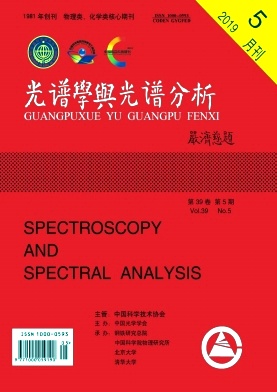光谱学与光谱分析, 2019, 39 (5): 1412, 网络出版: 2019-05-13
Dy3+对Tb3+激活硅酸盐氟氧闪烁玻璃发光性能的影响
Effect of Dy3+ on Luminescence Properties of Tb3+ Activated Silicate Oxyfluoride Scintillating Glass
摘要
采用高温熔融法制备了Dy3+或Tb3+单掺和Dy3+/Tb3+共掺硅酸盐氟氧闪烁玻璃。 通过对傅里叶变换红外光谱、 透射光谱、 光致激发和发射光谱、 X射线激发发射光谱及荧光衰减曲线的分析, 研究Dy3+与Tb3+之间的能量传递关系以及Dy3+对Tb3+激活硅酸盐氟氧闪烁玻璃发光性能的影响。 实验结果表明: Dy3+/Tb3+共掺硅酸盐氟氧闪烁玻璃具有较高的密度和良好的可见区透过率, 玻璃的网络结构是由[SiO4]四面体和[AlO4]四面体连接构成。 在紫外光激发时, Dy3+单掺玻璃的发光源于Dy3+的4F9/2→6H15/2(483 nm), 6H13/2(576 nm)的跃迁发射, 而Tb3+单掺玻璃的发光则源于Tb3+的5D4→7F6(489 nm), 7F5(544 nm), 7F4(586 nm)和7F6(623 nm)的跃迁发射。 对于Dy3+/Tb3+共掺玻璃, 发射光谱则主要由Tb3+的荧光发射组成。 通过对不同波长紫外光激发的发射光谱分析发现, Dy3+/Tb3+共掺闪烁玻璃中存在多种形式的能量传递。 在以Dy3+的特征激发452 nm为激发波长时, Tb3+单掺玻璃的发光很弱。 但随着Dy3+的引入, 通过4F9/2(Dy3+)→5D4(Tb3+)的能量传递, Tb3+发光得到敏化增强。 Dy3+/Tb3+共掺玻璃的发光强度随着Dy2O3含量的增多而增强, Dy2O3含量为1 mol%时达到最大, 更高Dy2O3含量的样品由于Dy3+的浓度猝灭, 减少了向Tb3+的能量传递, 发光强度减弱。 当激发波长减小到350 nm时, Dy3+和Tb3+均被激发到更高的能级6P7/2(Dy3+)和5L9(Tb3+), 此时除了4F9/2(Dy3+)→5D4(Tb3+)的能量传递外, 还出现了5D4(Tb3+)→4F9/2(Dy3+)的能量回传。 Dy3+掺杂浓度较低时, Dy3+→Tb3+能量传递作用较强, Tb3+发光得到敏化增强。 随着Dy2O3含量的增多, Tb3+→Dy3+能量传递作用增强。 当Dy2O3含量超过0.4 mol%时, Tb3+→Dy3+能量传递强于Dy3+→Tb3+能量传递, 减少了Tb3+的辐射跃迁发光, 因此Dy3+/Tb3+共掺玻璃的发光强度开始减弱。 由于Gd3+向Dy3+或Tb3+均可进行有效的能量传递, 因此在以Gd3+的特征激发274 nm为激发光时, Dy3+/Tb3+共掺玻璃中出现了Dy3+和Tb3+对Gd3+传递能量的竞争。 随着Dy2O3含量的增多, Tb3+所获得的能量不断减少, 同时伴随着Tb3+→Dy3+能量回传和Dy3+之间的无辐射交叉弛豫作用, Dy3+/Tb3+共掺玻璃的发光强度不断减弱。 对Dy3+/Tb3+共掺闪烁玻璃中Tb3+的5D4→7F5荧光衰减曲线分析还发现, 随着Dy2O3含量的增多, Tb3+的荧光寿命从2.24 ms缩短到1.15 ms, 曲线从单指数形式变为双指数形式, 进一步证明玻璃中存在5D4(Tb3+)→4F9/2(Dy3+)的能量回传。 X射线激发发射光谱显示, Dy3+的引入对Tb3+激活闪烁玻璃的辐射发光具有很强的负面影响, 而这种负面影响不足以通过Dy3+→Tb3+能量传递来弥补, 因此Dy3+/Tb3+共掺玻璃的辐射发光强度随着Dy2O3含量的增多而不断减弱。 由此可见, 在Tb3+激活硅酸盐氟氧闪烁玻璃中, 不宜将Dy3+作为敏化剂, 用于增强Tb3+的发光。
Abstract
Dy3+, Tb3+ doped and Dy3+/Tb3+ co-doped silicate oxyfluoride scintillating glass were prepared by high temperature melting method. The Fourier transform infrared spectra, transmission spectra, photoluminescence excitation and emission spectra, X-ray excited luminescence spectra and luminescence decay curves were analyzed. The influence of the energy transfer between Dy3+ and Tb3+ions and Dy3+doping onluminescence properties of Tb3+ activated silicate oxyfluoride scintillating glass was studied. The results indicated that Dy3+/Tb3+ co-doped silicate oxyfluoride scintillating glass has relatively high density and good transmittance in visible region. The networkstructure of glass isconstituted of tetrahedral [SiO4] and [AlO4]. Under the irradiation of ultraviolet light, the luminescence of Dy3+-doped glass originates from 4F9/2→6H15/2 (483 nm) and 6H13/2 (576 nm) transition emission of Dy3+ ions, while the luminescence of Tb3+-doped glass originates from 5D4→7F6 (489 nm), 7F5 (544 nm), 7F4 (586 nm) and 7F6 (623 nm) transition emission of Tb3+ ions. As for Dy3+/Tb3+ co-doped silicate oxyfluoride scintillating glasses, the emission spectra aremainly due to fluorescence emission of Tb3+ ions. The emission spectra under ultraviolet excitation with different wavelengths revealed that Dy3+/Tb3+ co-doped scintillating glass includes manifold energy transfers. When Tb3+-doped glass is excited by the characteristic excitation wavelength (452 nm) of Dy3+ ions, the luminous intensity of Tb3+-doped glass is very weak. With the introduction of Dy3+ ions, Tb3+ ions emission are sensitized and enhanced by the energy transfer of 4F9/2 (Dy3+)→5D4 (Tb3+). The luminous intensity ofDy3+/Tb3+ co-doped glassesis improved with the increase of Dy2O3. The luminous intensity ofDy3+/Tb3+ co-doped glasses reaches the maximum when the content of Dy2O3 is 1mol%. However, when the content of Dy2O3 is further increased, the concentration of Dy3+ ions is quenched, which results in the decrease of the energy transfer to Tb3+ions and the reduction of the luminous intensity. When the excitation wavelength is decreased to 350 nm, Dy3+ and Tb3+ ions are excited to higher energy levels of 6P7/2 (Dy3+) and 5L9 (Tb3+). At this point, the energy transfer of both 4F9/2 (Dy3+)→5D4 (Tb3+) and 5D4(Tb3+)→4F9/2 (Dy3+) occurs. When the doping concentration of Dy3+ ions is relatively low, the energy transfer of Dy3+→Tb3+ is stronger than that of Tb3+→Dy3+, which enhancesthe luminescence of Tb3+ ions by sensitization. With the increase of Dy2O3 content, the energy transfer of Tb3+→Dy3+ is enhanced. When the content of Dy2O3 is above 0.4 mol%, the energy transfer of Tb3+→Dy3+ is strongerthan that of Dy3+→Tb3+, which reduces the transition luminescence of Tb3+ ions and thus decreases theluminous intensity of Dy3+/Tb3+ co-doped glass. Due to the efficient energy transfer from Gd3+ to Dy3+ or Tb3+, the competition of energy transferfrom Gd3+ to Dy3+ and Tb3+ion soccurs under characteristic excitation wavelength of Gd3+ ion at 274 nm. With the increase of content of Dy2O3, the captured energy of Tb3+ions decreases constantly. At the same time, the energy backtransfer of Tb3+→Dy3+ and the nonradiative cross relaxation between Dy3+ ions appear, which leads to the reduction of theluminous intensity of Dy3+/Tb3+ co-doped glass. The 5D4→7F5 luminescence decay curves of Tb3+ions for Dy3+/Tb3+co-doped scintillating glass showed that with the increase of Dy2O3 content, the lifetime of 5D4 (Tb3+) reduces from 2.24 to 1.15 ms and the curve changes from single-exponential to double-exponential form, indicating the possibility of the energy back transfer of 5D4 (Tb3+)→4F9/2 (Dy3+) in the glass. The X-ray excited luminescence emission spectra showed that the introduction of Dy3+ ions has a negative effect on the luminescence of Tb3+ activated scintillating glass. Becausethat negative effect is not enough to make up for the Dy3+→Tb3+ energy transfer, the radiation luminescence intensity of Dy3+/Tb3+ co-doped glass decreases with the increase of the Dy2O3 content. Therefore, Dy3+ ions should not be used as sensitizers to enhance the luminescence intensity of Tb3+ ions in Tb3+ activated silicate oxyfluoride scintillating glass.
张勇, 朱金铭, 杨丽丽, 吕世权, 武彦群, 楚学娟. Dy3+对Tb3+激活硅酸盐氟氧闪烁玻璃发光性能的影响[J]. 光谱学与光谱分析, 2019, 39(5): 1412. ZHANG Yong, ZHU Jin-ming, YANG Li-li, L Shi-quan, WU Yan-qun, CHU Xue-juan. Effect of Dy3+ on Luminescence Properties of Tb3+ Activated Silicate Oxyfluoride Scintillating Glass[J]. Spectroscopy and Spectral Analysis, 2019, 39(5): 1412.



